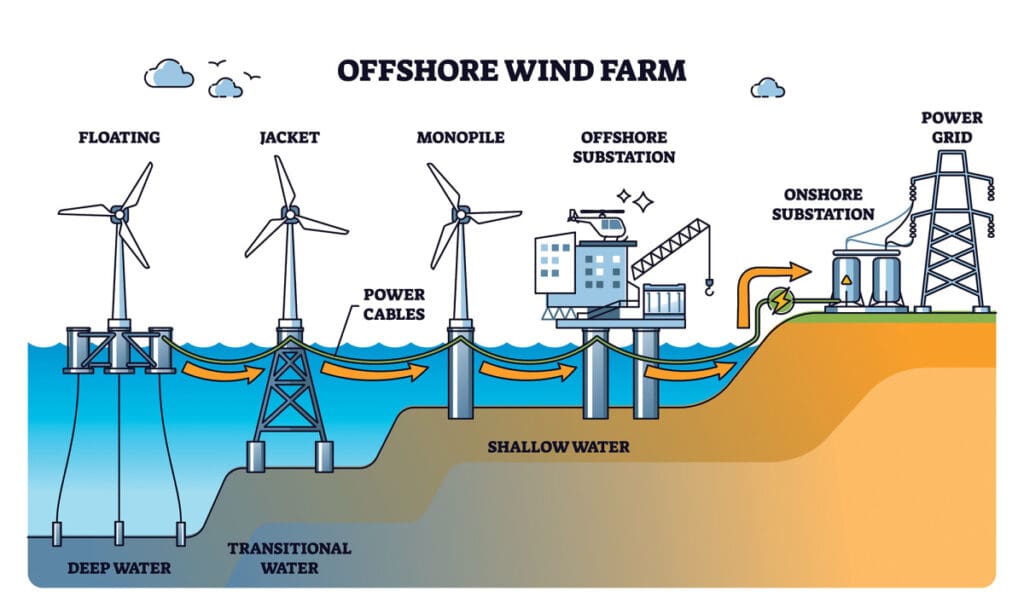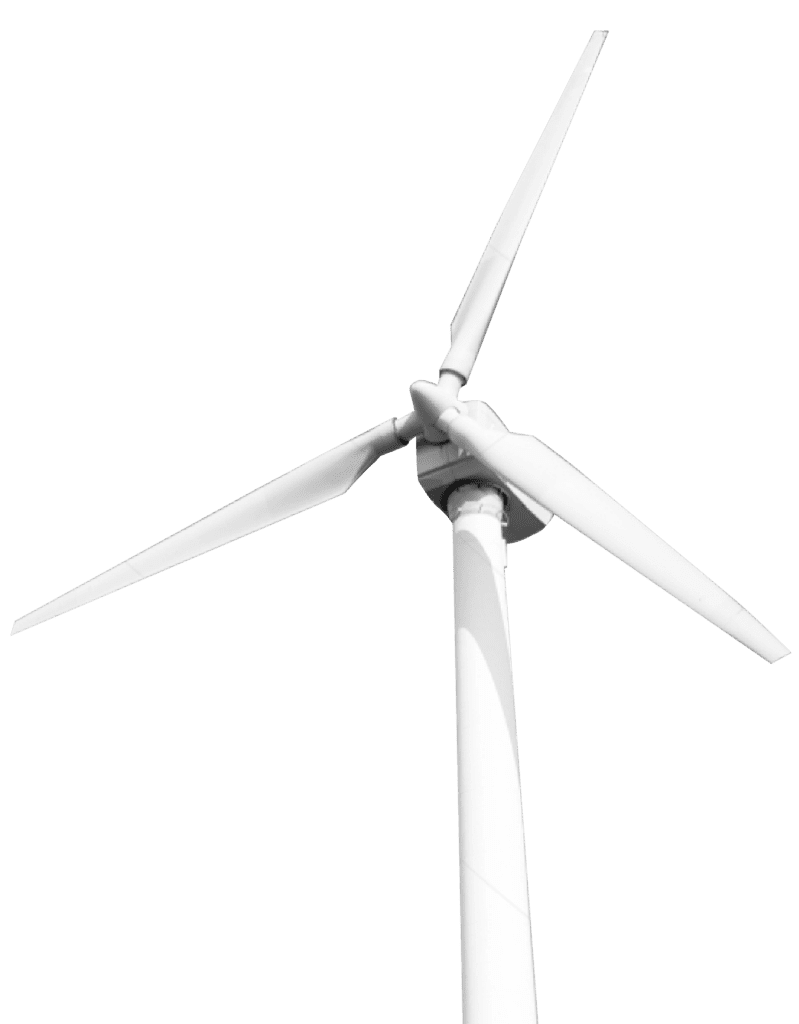WHAT IS
OFFSHORE WIND
Offshore wind farms differ from their onshore counterparts, in that they consist of arrays of wind turbines along with electrical substations located out to sea. This is for several reasons including stronger and more consistent winds, less turbulence, low visual impact and the elimination of noise issues. Because of these factors, larger wind turbines are possible, exceeding the typical size of onshore wind farms.
How Do Offshore Wind Farms Work?
Power is generated from offshore wind using very large turbines installed out at sea. Through a series of cables, electricity is transmitted to an offshore high voltage electrical substation where it is collected and exported to an onshore electrical substation. Once there it is distributed via onshore grid infrastructure to power homes, businesses, and industry.

STRATEGY
Why Offshore Wind
Offshore wind presents an optimistic outlook for Aotearoa New Zealand, capitalising on its world-class wind resources and suitable seabed depths in specific coastal areas. This has the potential to significantly increase electricity production, doubling (or even trippling) our renewable energy output by 2050 and facilitating the emergence of new energy-intensive industries for our growing economy.
Offshore wind turbines typically exhibit efficient operation, characterised by a high capacity-factor (CF), denoting the ratio of actual electricity produced compared to its maximum potential. For example, offshore wind farms could yield 2 – 3 times more electricity produced than from solar PV systems of an equivalent size.
Furthermore, offshore wind farms boast benefits such as minimal visual impact and low noise levels, depending on the distance from the coastline.
STRATEGY
There are five offshore wind developers based in Aotearoa New Zealand and are keen on developing offshore wind energy projects over the next decade and beyond. The five NZWEA members are:
- Elemental Group Partnership
- Taranaki Offshore Partnership (NZ Super Fund/Copenhagen Infrastructure Partners)
- Energy Quarry Zealandia
- JERA Nex bp
- Sumitomo Corporation
Developers are advancing various feasibility and environmental studies, while also engaging with iwi, hapū, communities, and stakeholders to understand their concerns and address their inquiries.
The global demand for offshore wind energy has dramatically increased in recent years, with almost 8 GW added in 2024 taking the global offshore installed capacity to over 83.2 GW. It is predicted that by 2030, the global installed capacity will increase to 380 GW.
In May 2022, the Government pledged to create regulatory conditions supporting investment in offshore renewable energy, as part of efforts to accelerate new renewable electricity generation. In early 2024, this commitment was reaffirmed.
The Ministry of Business, Innovation and Employment (MBIE) is actively working on establishing a regulatory framework for offshore wind energy. This involves identifying gaps in regulations and considering how to balance impacts on various marine, community and iwi interests. The framework will outline procedures for parties interested in exploring and developing wind energy in New Zealand’s territorial waters and Exclusive Economic Zone.
On 9th December 2024, a draft Offshore Renewable Energy (ORE) bill was introduced to parliament, and on the 17th December it passed its first reading. Consultation on the draft bill is now complete and the select committee has recommended the introduction of the legislation to Cabinet. It is expected that the final ORE bill will be passed into law during Q4 of 2025 and the first round of feasibility permits offered to the commercial market in Q1 2026. For more information on the process, see Offshore Renewable Energy Bill.

Find out what Offshore Wind projects are being investigated for Aotearoa New Zealand in the coming years.
How much electricity do turbines produce?
Wind turbines currently used for offshore applications are generally much larger than onshore, at 15 MW – 16 MW capacities, and are up to around 230m in rotor diameter with a top blade tip height of around 260m.
Will they be visible from the coast?
Depending on the distance of the wind farm from land (typically 20km), the offshore wind farm may be visible from some coastal areas. However, this will depend on the weather conditions and the design of the project. A project may have some (unavoidable) visual impact however it can be minimised through careful location, and colouring. The attractiveness of wind turbines is subjective; however, many people consider these slowly rotating giants to be very graceful.
What locations are the offshore windfarms?
There are currently no confirmed locations, but South Taranaki, Waikato and Southland are being looked at as potential locations.
Why do we need to build offshore windfarms when we have so many onshore windfarm opportunities?
Both onshore and offshore wind energy will be needed to meet New Zealand’s increasing demand for clean energy. Offshore wind farms harness the typically stronger and more consistent winds found out at sea and don’t take up valuable land.
Does it affect our fishing industry?
Offshore wind farms are typically built quite a long way out at sea. While they occupy a reasonably large area, boats may be able to pass in between turbines with few restrictions. There is some evidence that the presence of wind turbine foundation structures attracts sea life to the area. Indeed, the area can provide a refuge for sea life where they are protected and can find plenty of hard substrate to feed, hide and breed.
How long do the turbines operate for and what happens at the end?
Typically, in the range of 25-35 years for turbines and steel structures and longer for concrete components, dependent on site and project conditions. Most turbine components can be recycled. Historically, blades have been the most challenging element to recycle. Manufacturers are actively working on improving the recyclability of blades and there is ongoing research and development in this area, which is gaining considerable momentum. See Vestas unveils circularity solution to end landfill for turbine blades.
Why use fixed or floating foundations?
Most offshore wind turbine foundations are driven directly into the seafloor and can be installed in waters up to 60m deep. Floating turbines have recently been developed which are tethered by chains to the seafloor. These floating turbines can operate in much deeper water.
What is the carbon footprint of an offshore wind farm?
The electricity produced from an offshore wind farm is free of greenhouse gas (GHG) emissions. However, GHG emissions do occur during the construction, operation and decommissioning of the entire system over its lifetime, and this constitutes the carbon footprint. Published studies between 2009 and 2014 found carbon footprints for offshore windfarms of 5.2 -32g-CO2e/kWh.
FAQ's
View some of our most frequently asked questions about offshore wind farms